
 |
|
When I first met Master Wu De, he gave me a big, long hug. I was a little nervous, since before our meeting, my teacher, Tsai Yizhe, had told me that we were about to meet the author of The Way of Tea. Wu De is a man with a profound understanding of the Way of Tea, a practitioner of Buddhism and a tea master. Although we had never met before, I could already feel my admiration welling up inside me well before we greeted. To a traditional Chinese girl, a hug is something that is reserved for one's lover or a close female friend. We seldom even hug our parents. Though I was shy, Wu De smiled and said: "Snow, you're going to have to get used to hugging. You're going on a Global Tea Hut trip and we're all huggers. You will probably get hugged a lot over the next week or so! And you may even grow to like it." And with that, my journey to the tea mountains began.
All together we were twenty-five people, led by our teachers, Wu De and Tsai. Master Tsai came from Taiwan. I myself am a Yunnan native. Wu De and the twenty-two other members of our group came from different countries around the world.
On May 5th, at nine in the morning, we set off from Kunming. By the time we reached Qian Jia Zhai, it was already midnight. After the fifteen-hour trip, we were all exhausted, but the next day we were up bright and early in anticipation of the day's "conversation with Tea." We set off in the direction of the waterfall called "Da Diao Shui." Halfway through the day, I was surprised to see that some of the friends in our group had taken off their shoes and were walking barefoot. The mountain paths were no easy walk, covered in water, large holes, and jagged rocks. I began to wonder if perhaps walking barefoot was their way of getting closer to the land we now traveled through, the land on which grew tea trees up to 2700 years old. Da Diao Shui is one of Qian Jia Zhai's most beautiful waterfalls. Though the early May temperatures had risen to over 30 °C, the refreshing waters washed away the heat of our long journey.
We drew some water from beneath the falls to brew tea. This was my first time drinking tea with members of Global Tea Hut. Everything was calm. This was a different way of drinking tea. Throughout the time it took for the water to boil, nearly everyone sat silently. Those first few minutes felt completely unusual to me. I almost didn't dare to breathe. I closed my eyes and cleared my mind, and soon I, too, began to calm down. This allowed my mind to organize recent events - things which were confusing became increasingly clear, and any ill feelings I had were met by an internal voice telling me to let go. I was having an internal conversation, which was fascinating.
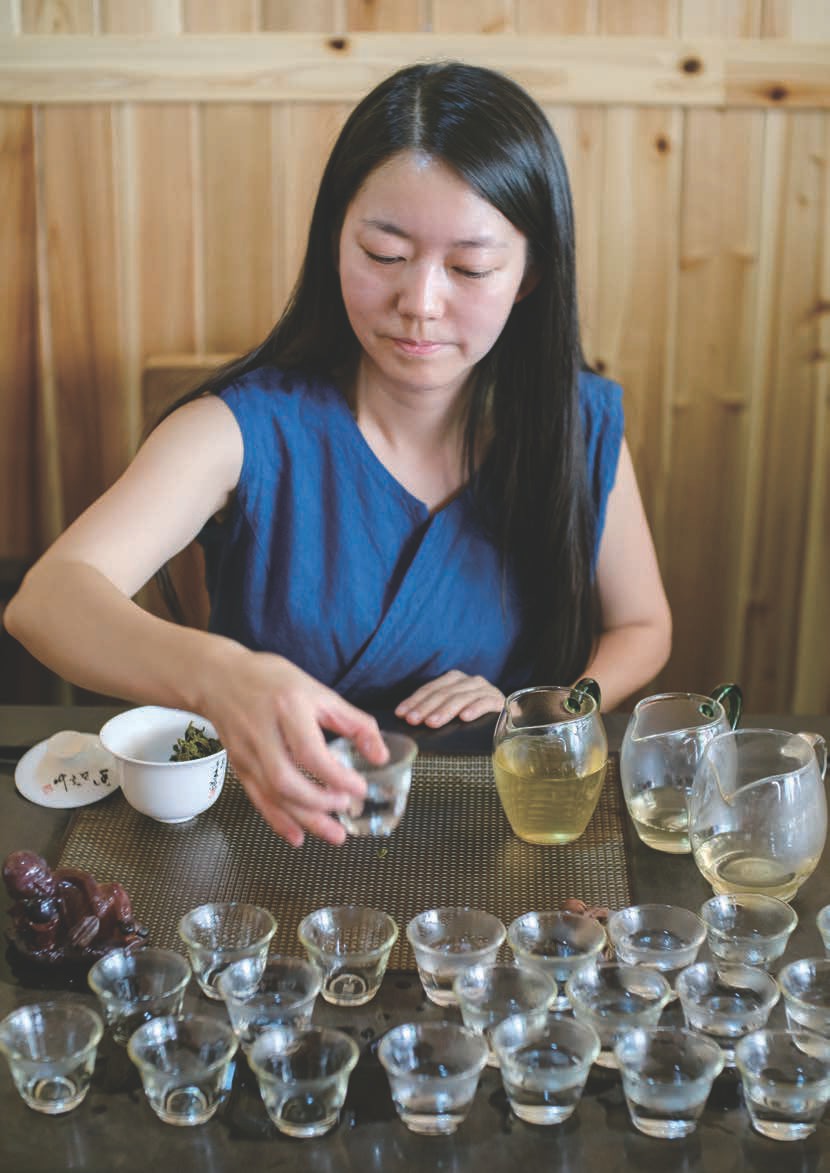
The water finished boiling. Wu De steeped the tea himself, offering us each a bowl of the leaves of ancient tea trees from the area. The flavor was extremely sweet and clear. Wu De's tea steeping technique was very unique. I decided to quietly copy his methods in my mind and practice them once I returned home.
We then took part in the process of traditional red tea production: withering, rolling, oxidizing and sun-drying. Rolling was an interesting process. Despite many hours of work, our leaves were still not ripe enough. Perhaps we needed the farmers' lifetimes of experience to properly roll the tea leaves and bring out their fragrant and pure flavors. Our tea did have joy in it, though!
Our next stop after Ai Lao was the Jingmai Old-Growth Tea Garden. Our lodgings were located among the tea mountains. Stepping out the door, one could see the tea trees and mountain slopes covered in wild flowers.
Master Tsai had asked his local friends to help us prepare some fresh leaves in order to produce puerh tea. From withering, de-enzyming, rolling, sun drying and pressing to the very last step of wrapping the cake in paper, each person participated in every step to personally handcraft his or her own cake of puerh. Drinking a cup of tea is easy, but producing tea is not so simple. Tea farmers pick leaves in 35°C weather, and oftentimes simply walking to the tea mountains can take hours. During the de-enzyming, one must use one's bare hands to roast the leaves in a large iron pot over a hot fire (though farmers in Jingmai have started wearing gloves). In less than five minutes one's entire body is drenched in sweat. Yet, when that sweat is put into the leaves, a more beautiful cup of tea is created.
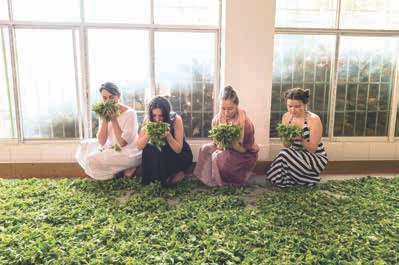
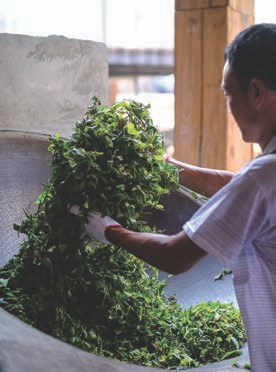
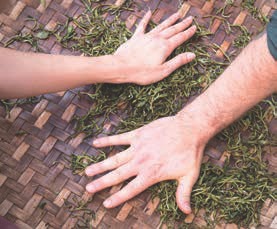
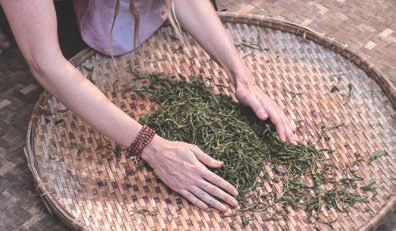


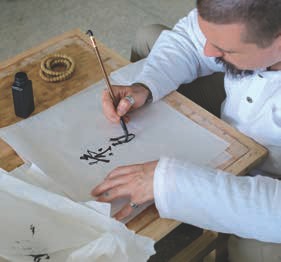

Under the guidance of our local friends, we were lucky enough to see Crab's Claw (a kind of leafless mistletoe) growing on the tea trees. Crab's Claw is a very interesting parasitic plant that can only be found in areas with the proper natural ecology. Some examples can be found growing in the natural forests of Yunnan, while others can appear on tea trees that are hundreds or even thousands of years old. Because Crab's Claw absorbs the energy and essence of the tea tree it attaches to, it has the ability to reduce blood pressure, fat and blood sugar, soften the arteries, cleanse the gallbladder, induce diuresis, and treat stomach flus, among many other beneficial effects.
The Jingmai tea garden left every one of us stunned! The ancient tea trees, lush vegetation and balanced ecology - all were in perfect harmony. It is difficult to find words to describe how I felt sitting around the thousand-year-old Guardian Tree, drinking bowls of puerh tea steeped in the mountain spring water we had carried into the tea garden. I can only say that I felt as if I had become one with the ancient forest, where the elements and essence of Nature seemed to come together.
In my ten days with the group, my happiest moments were those in which we drank silent tea together, produced our own tea as a group, and, yes, the hugs we shared. As Wu De had said, I was hugged quite often. He was also right that by the end I began to appreciate hugs a lot more! (I even hugged a few people on my own initiative!)
In seeing each new friend treasure the tea in their bowls, express their love for Yunnan and the local tea they encountered on this journey, and demonstrate their great respect for Nature, I felt deeply moved. Even now, I am touched to know that there is a group of lovely people willing to come to my native home to help protect the natural environment and support the ecology of Tea and aboriginal culture, and to do so with such reverence. I am extremely grateful for that.
In a bowl of fine tea, there is Nature. There is a Way of life. There is water, mountains, birds, and even the sounds of insects. I hope that through Global Tea Hut, more people get the chance to drink such bowls.
